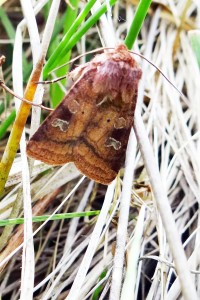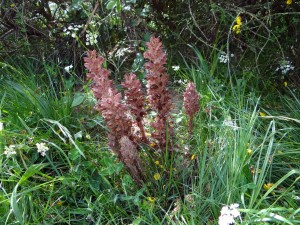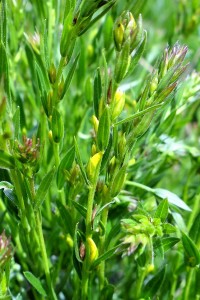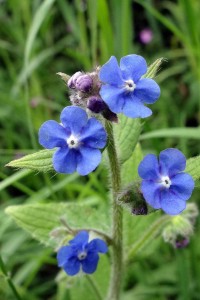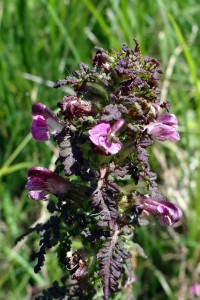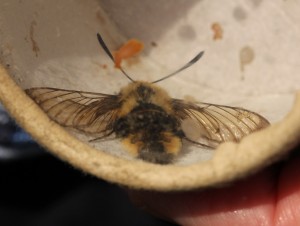On a sunny, warm day, Sarah and Ken White led a group of 16 members around the National Nature Reserve at Ashford Hill. Walking from the car park in the village to the reserve we found Green Alkanet, Greater Celandine, Tall Fescue and False Fox-sedge. In the reserve itself, we then explored several of the wildflower meadows before heading into the SSSI woodland (Redlands Copse) to the east of the reserve, where we saw Pale Sedge, Wood Melick and Common Cow-wheat. After a picnic lunch, we re-entered the NNR from the south-eastern end accompanied by Bob Winfield, a volunteer warden with twenty years’ experience of the site. Bob described the geology of the area and explained the history and management of the reserve which together have led to the development of the rich and diverse habitats and a wide range of flora and fauna, several of which are locally rare.
The first meadow (Pipers Piece) was a typical unimproved meadow on London Clay and Lower Bagshot Beds. In this area we saw Kites, Buzzards and Treecreepers and heard Goldfinches, Blackbirds and Chiffchaffs. A wet boggy area here contained Greater Tussock-sedge, Great Yellow Cress, Common Valerian, Ragged Robin, Bladder Sedge, Remote Sedge and Water Plantain.
The next meadow was very different: it was drier with a sandy, acidic soil and a large number of anthills made by the Meadow Ant. Here were large areas of Pignut in flower, Oval sedge, Sweet Vernal Grass, Hairy Sedge, Glaucous Sedge, Tormentil, Cat’s-ear, Heath Spotted Orchids, Heath and Germander Speedwell, Marsh Thistle and Bitter Vetch. The plant species growing on top of the anthills were noticeably different from those growing in the rest of the sward. For example, Mouse-ear Hawkweed, Spring Sedge, Large Thyme and Dyer’s Greenweed grew only on the anthill tops. We saw a Kingfisher and heard a Chiffchaff, Garden Warbler, Green Woodpecker and Blackcap. We saw a Common Blue, an Orange Tip, a Scorpion Fly, a Straw Dot Moth, a Burnet Companion, a Small Yellow Underwing and a Narrow-bordered Bee Hawkmoth. The latter was a particularly good find, being only the third record in Hampshire for the last 3 years and a new 10km square record. The unmistakeable sound of noisy young Great Spotted Woodpeckers led us to their nest-hole at the edge of the wood.
In the particularly species-rich, marshy area at the south-eastern end of the reserve we saw Square-stemmed St. John’s Wort, Marsh Valerian, Marsh Lousewort, Marsh Pennywort, Star Sedge, Common Cottongrass, Bog Pimpernel, Wood Club-rush, Water Figwort and Gypsywort.
Walking back through the reserve along the boardwalk, we heard Bullfinch, Reed Bunting, Turtle Dove and Water Rail. Lastly, Bob showed us one of the specialities of the reserve: Greater Broomrape, nestled under a flowering Broom.
| Achillea millefolium | Yarrow | Gnaphalium uliginosum | Marsh Cudweed | |
| Ajuga reptans | Bugle | Glyceria fluitans | Floating Sweet-grass | |
| Alisma plantago aquatica | Water Plantain | Genista tinctoria | Dyer’s Greenweed | |
| Alliaria petiolata | Garlic Mustard | Holcus lanatus | Yorkshire Fog | |
| Alnus glutinosa | Alder | Hyacinthoides non scripta | Bluebell | |
| Alopecurus geniculatus | Marsh Foxtail | Hydrocotyle vulgaris | Marsh Pennywort | |
| A. pratensis | Meadow Foxtail | Hypericum pulchrum | Slender St John’s-wort | |
| Anagallis tenella | Bog Pimpernel | Hypericum tetrapterum | Square-stalked St John’s-wort | |
| Anemone nemorosa | Wood Anemone | Hypochaeris radicata | Cat’s-ear | |
| Angelica sylvestris | Wild Angelica | Iris pseudacorus | Yellow Iris | |
| Anisantha sterilis | Sterile Brome | Juncus bufonius | Toad Rush | |
| Anthoxanthum odoratum | Sweet Vernal grass | J. effusus | Soft Rush | |
| Anthriscus sylvestris | Cow Parsley | Lathyrus linifolius | Bitter-vetch | |
| Apium nodiflorum | Fool’s Water Cress | Lolium perenne | Perennial Rye-grass | |
| Arctium minus | Lesser Burdock | Lotus corniculatus | Common Bird’s-foot Trefoil | |
| Bellis perennis | Daisy | L. pedunculatus | Greater Bird’s-foot Trefoil | |
| Blechnum spicant | Hard fern | Luzula multiflora | Heath wood-rush | |
| Caltha palustris | Marsh Marigold | L. pilosa | Hairy Wood-rush | |
| Cardamine flexuosa | Wavy Bitter-cress | Lycopus europaeus | Gypsywort | |
| C. pratensis | Cuckooflower | Melampyrum pratense | Common Cow-wheat | |
| Carex acutiformis | Lesser Pond-sedge | Melica uniflora | Wood Melick | |
| C. caryophyllea | Spring-sedge | Mentha aquatica | Water Mint | |
| C. disticha | Brown Sedge | Moehringia trinerva | Three-nerved Sandwort | |
| C. echinata | Star Sedge | Myosotis scorpioides | Water Forget-me-not | |
| C. flacca | Glaucous Sedge | Oenanthe crocata | Hemlock Water-dropwort | |
| C. hirta | Hairy Sedge | Orobanche rapum-genistae | Greater Broomrape | |
| C. leporina | Oval Sedge | Pedicularis palustris | Marsh Lousewort | |
| C. otrubae | False Fox-sedge | Pentaglottis sempervirens | Green Alkanet | |
| C. panicea | Carnation Sedge | Pilosella officinarum | Mouse-ear-hawkweed | |
| C. pallescens | Pale Sedge | Plantago lanceolata | Ribwort Plantain | |
| C. paniculata | Greater Tussock-sedge | Poa trivialis | Rough Meadow-grass | |
| C. pilulifera | Pill Sedge | Polygonatum multiflorum | Solomon’s-seal | |
| C. remota | Remote Sedge | Ranunculus acris | Meadow Buttercup | |
| C. sylvatica | Wood Sedge | R. bulbosus | Bulbous Buttercup | |
| C. vesicaria | Bladder Sedge | R. flammula | Lesser Spearwort | |
| Centaurea nigra | Common Knapweed | R. repens | Creeping Buttercup | |
| Cerastium fontanum | Common Mouse-ear | Rhinanthus minor | Yellow-rattle | |
| Chelidonium majus | Greater Celandine | Rorippa amphibia | Great Yellow-cress | |
| Chrysosplenium oppositifolium | Opposite-leaved Golden Saxifrage | Scirpus sylvaticus | Wood Club-rush | |
| Circaea lutetiana | Enchanter’s Nightshade | Schedonorus arundinaceus | Tall Fescue | |
| Cirsium arvense | Creeping Thistle | Scrophularia auriculata | Water Figwort | |
| Cirsium dissectum | Meadow Thistle | Scrophularia nodosa | Figwort | |
| C. palustre | Marsh Thistle | Silene dioica | Red Campion | |
| Conopodium majus | Pignut | Silene flos-cuculi | Ragged Robin | |
| Crataegus monogyna | Hawthorn | Solanum dulcamara | Woody Nightshade | |
| Crepis vesicaria | Beaked Hawk’s-beard | Stellaria alsine | Bog Stitchwort | |
| Cruciata laevipes | Crosswort | S. graminea | Lesser Stitchwort | |
| Cynosurus cristatus | Crested Dog’s-tail | S. holosteoides | Greater Stitchwort | |
| Cytisus scoparius | Broom | Succisa pratensis | Devil’s-bit Scabious | |
| Dactylis glomerata | Cock’s-foot | Thymus pulegioides | Large Thyme | |
| Dactylorhiza maculata | Heath Spotted-orchid | Trifolium dubium | Lesser Trefoil | |
| Deschampsia cespitosa | Tufted Hair-grass | T. pratense | Red Clover | |
| Digitalis purpurea | Foxglove | Triglochin palustris | Marsh Arrow Grass | |
| Equisetum arvense | Field Horsetail | Typha latifolia | Bulrush | |
| E. palustre | Marsh Horsetail | Ulex europaeus | Gorse | |
| Eriophorum angustifolium | Common Cottongrass | Valeriana dioica | Marsh Valerian | |
| Eupatorium cannabinum | Hemp-agrimony | V. officinalis | Common Valerian | |
| Festuca rubra | Red fescue | Veronica beccabunga | Brooklime | |
| Ficaria verna | Lesser Celandine | V. chamaedrys | Germander Speedwell | |
| Filipendula ulmaria | Meadowsweet | V. montana | Wood Speedwell | |
| Galium saxatile | Heath Bedstraw | V. officinalis | Heath Speedwell | |
| G. verum | Lady’s Bedstraw | V. serpyllifolia | Thyme-leaved Speedwell | |
| Geum urbanum | Wood Avens | Vaccinium myrtillus | Bilberry | |
| Kingfisher | Great Spotted Woodpecker + nest | |||
| Buzzard | House Sparrow | |||
| Goldfinch | Jackdaw | |||
| Treecreeper | House Martin | |||
| Reed Bunting | Goldcrest | |||
| Red Kite | Kestrel | |||
| Chiffchaff | Blackcap | |||
| Green Woodpecker | Wren | |||
| Bullfinch | Great Tit | |||
| Water Rail | Jay | |||
| Turtle Dove | Robin | |||
| Garden Warbler | Song Thrush | |||
| Dunnock | Moorhen | |||
| Greenfinch | Nuthatch | |||
| Chaffinch | Whitethroat | |||
| Blackbird + juvenile | Magpie | |||
| Woodpigeon | Raven (3birds) | |||
| Blue Tit + nest | ||||
| Anthocharis cardamines | Orange Tip | Lycaena phlaeas | Small Copper | |
| Callophrys rubi | Green Hairstreak | Panemeria tenebrata | Small Yellow Underwing | |
| Callistege mi | Mother Shipton moth | Panorpa communis | Scorpion Fly (female) | |
| Euclidia glyphica | Burnet Companion | Pieris napi | Green-Veined White | |
| Gastrophysa viridula | Emerald Pot-bellied Beetle | Polyommatus icarus | Common Blue | |
| Gonepteryx rhamni | Brimstone | Pseudopanthera macularia | Speckled Yellow | |
| Hemaris tityus | Narrow Bordered Bee Hawkmoth | Rivula sericealis | Straw Dot Moth | |
| Inachis io | Peacock | Vanessa cardui | Painted Lady | |
| Libellula quadrimaculata | Four-spotted Chaser | |||

